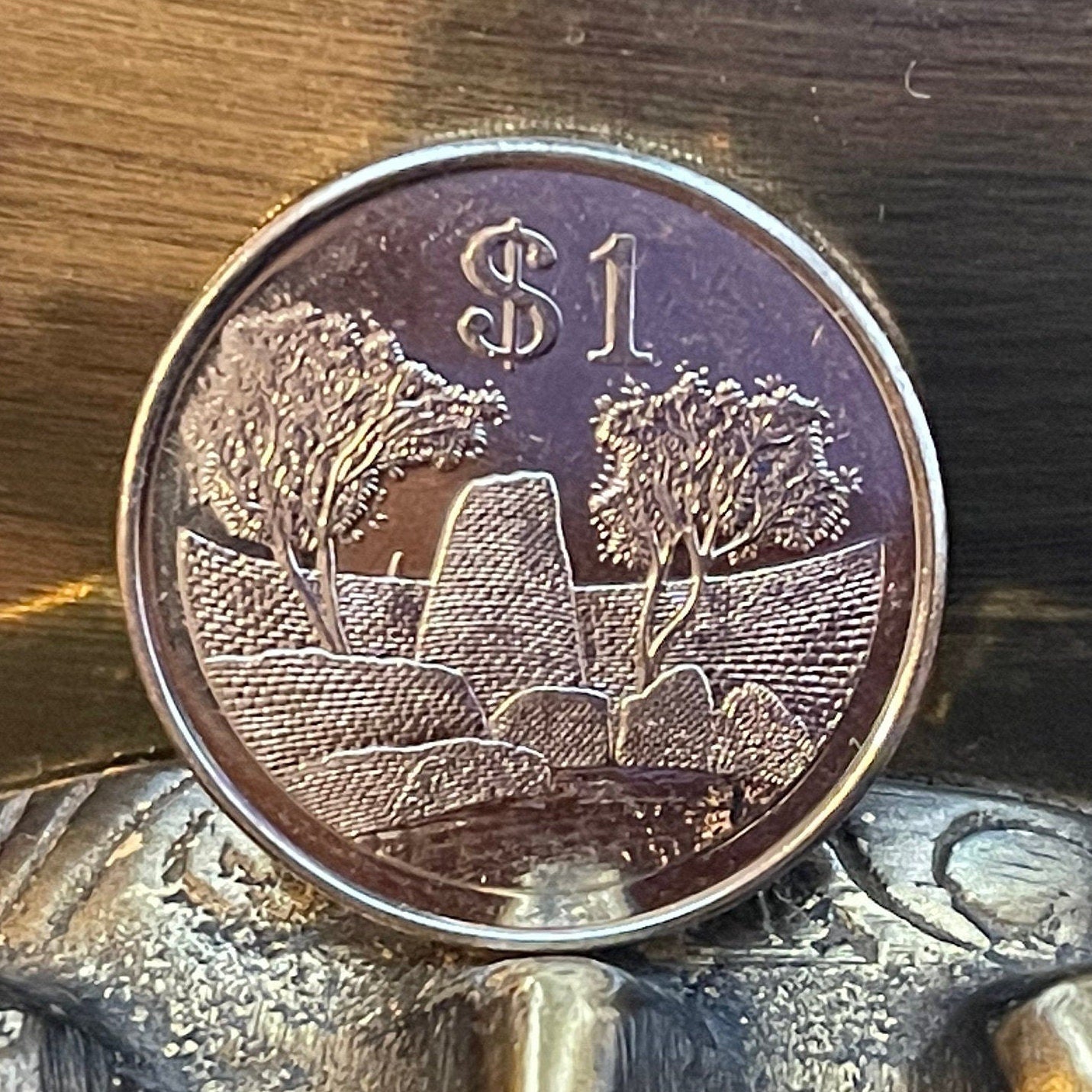elemintalshop
Great Zimbabwe City 1 Dollar Zimbabwe Authentic Coin Money for Jewelry and Craft Making (Great Zimbabwe Bird) (Bacheleur Eagle) (Shona)
Great Zimbabwe City 1 Dollar Zimbabwe Authentic Coin Money for Jewelry and Craft Making (Great Zimbabwe Bird) (Bacheleur Eagle) (Shona)
Couldn't load pickup availability
Great Zimbabwe City 1 Dollar Zimbabwe Authentic Coin Money for Jewelry and Craft Making (Great Zimbabwe Bird) (Bacheleur Eagle) (Shona)
Reverse: National Monument View of Great Zimbabwe, the remains of an ancient city of stone, built between the 13th and 15th century, the center of an empire that stretched on Zimbabwe and current Mozambique.
Lettering: $1
Obverse: Representation of the protective Great Zimbabwe Bird, the most famous of Zimbabwe sculptures dated between XII and XIV century. Protective sculpture in the city of Great Zimbabwe, the capital of Monomotapa Empire and led Gokomere ancestors of Shona, the people of southern Africa.
Features
Issuer Zimbabwe
Period Republic (1980-date)
Type Standard circulation coin
Years 2001-2003
Value 1 Dollar (1.00 ZWD)
Currency First Dollar (1980-2006)
Composition Stainless steel
Weight 10.1 g
Diameter 29.0 mm
Thickness 2.3 mm
Shape Round
Orientation Medal alignment ↑↑
Demonetized Yes
Number N# 12540
References KM# 6a, Schön# 60a
Wikipedia:
Great Zimbabwe is an ancient city in the south-eastern hills of Zimbabwe near Lake Mutirikwe and the town of Masvingo. It is thought to have been the capital of a great kingdom, although which kingdom is not certain, during the country's Late Iron Age. Construction on the city began in the 11th century and continued until it was abandoned in the 15th century. The edifices are believed to have been erected by the ancestral Shona. The stone city spans an area of 7.22 square kilometres (2.79 square miles) which, at its peak, could have housed up to 18,000 people. It is recognised as a World Heritage site by UNESCO.
Great Zimbabwe is believed to have served as a royal palace for the local monarch. As such, it would have been used as the seat of political power. Among the edifice's most prominent features were its walls, some of which are eleven metres high. They were constructed without mortar (dry stone). Eventually, the city was abandoned and fell into ruin.
The earliest known written mention of the Great Zimbabwe ruins was in 1531 by Vicente Pegado, captain of the Portuguese garrison of Sofala, on the coast of modern-day Mozambique, who recorded it as Symbaoe. The first confirmed visits by Europeans were in the late 19th century, with investigations of the site starting in 1871. Later, studies of the monument were controversial in the archaeological world, with political pressure being put upon archaeologists by the government of Rhodesia to deny its construction by native African people. Great Zimbabwe has since been adopted as a national monument by the Zimbabwean government, and the modern independent state was named after it. The word great distinguishes the site from the many hundreds of small ruins, now known as "zimbabwes", spread across the Zimbabwe Highveld. There are 200 such sites in southern Africa, such as Bumbusi in Zimbabwe and Manyikeni in Mozambique, with monumental, mortarless walls; Great Zimbabwe is the largest of these.
*******
Wikipedia:
The stone-carved Zimbabwe Bird is the national emblem of Zimbabwe, appearing on the national flags and coats of arms of both Zimbabwe and Rhodesia, as well as on banknotes and coins (first on the Rhodesian pound and then on the Rhodesian dollar). It probably represents the bateleur eagle or the African fish eagle. The bird's design is derived from a number of soapstone sculptures found in the ruins of the ancient city of Great Zimbabwe.
It is now the definitive icon of Zimbabwe, with Matenga (2001) listing over 100 organisations which now incorporate the Bird in their logo.
The original carved birds are from the ruined city of Great Zimbabwe, which was built by ancestors of the Shona, starting in the 11th century and inhabited for over 300 years. The ruins, after which modern Zimbabwe was named, cover some 730 hectares (1,800 acres) and are the largest ancient stone construction in sub-Saharan Africa. Among its notable elements are the soapstone bird sculptures, about 40 centimetres (16 inches) tall and standing on columns more than 90 cm (3 ft) tall, which were originally installed on walls and monoliths within the city. They are unique to Great Zimbabwe; nothing like them has been discovered elsewhere.
Various explanations have been advanced to explain the symbolic meaning of the birds. One suggestion is that each bird was erected in turn to represent a new king, but this would have required improbably long reigns. More probably, the Zimbabwe birds represent sacred or totemic animals of the Shona – the bacheleur eagle (Shona: chapungu), which was held to be a messenger from Mwari (God) and the ancestors, or the fish eagle (hungwe) which it has been suggested was the original totem of the Shona.
Share



















